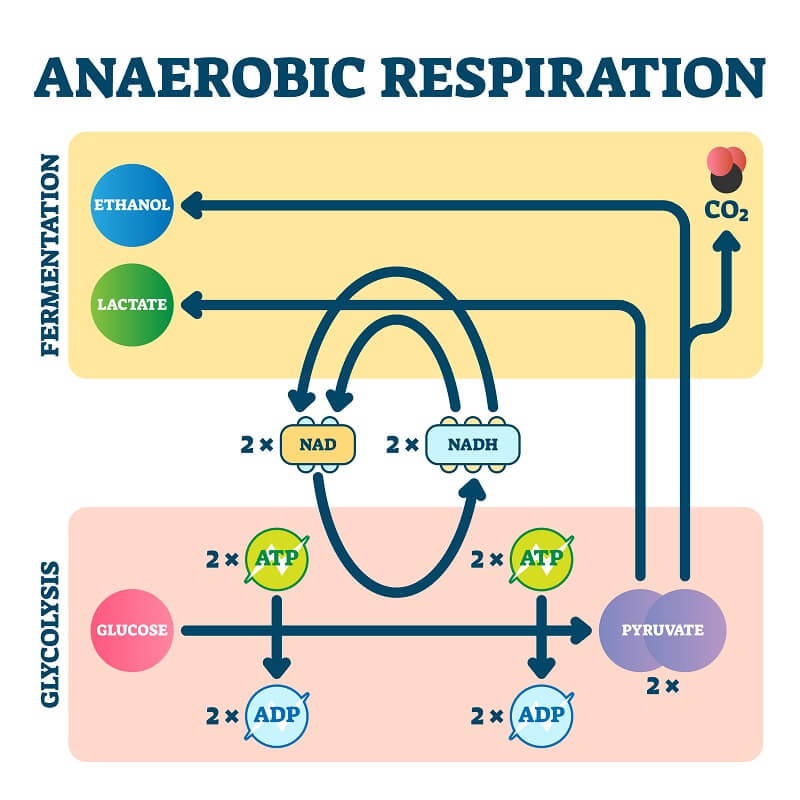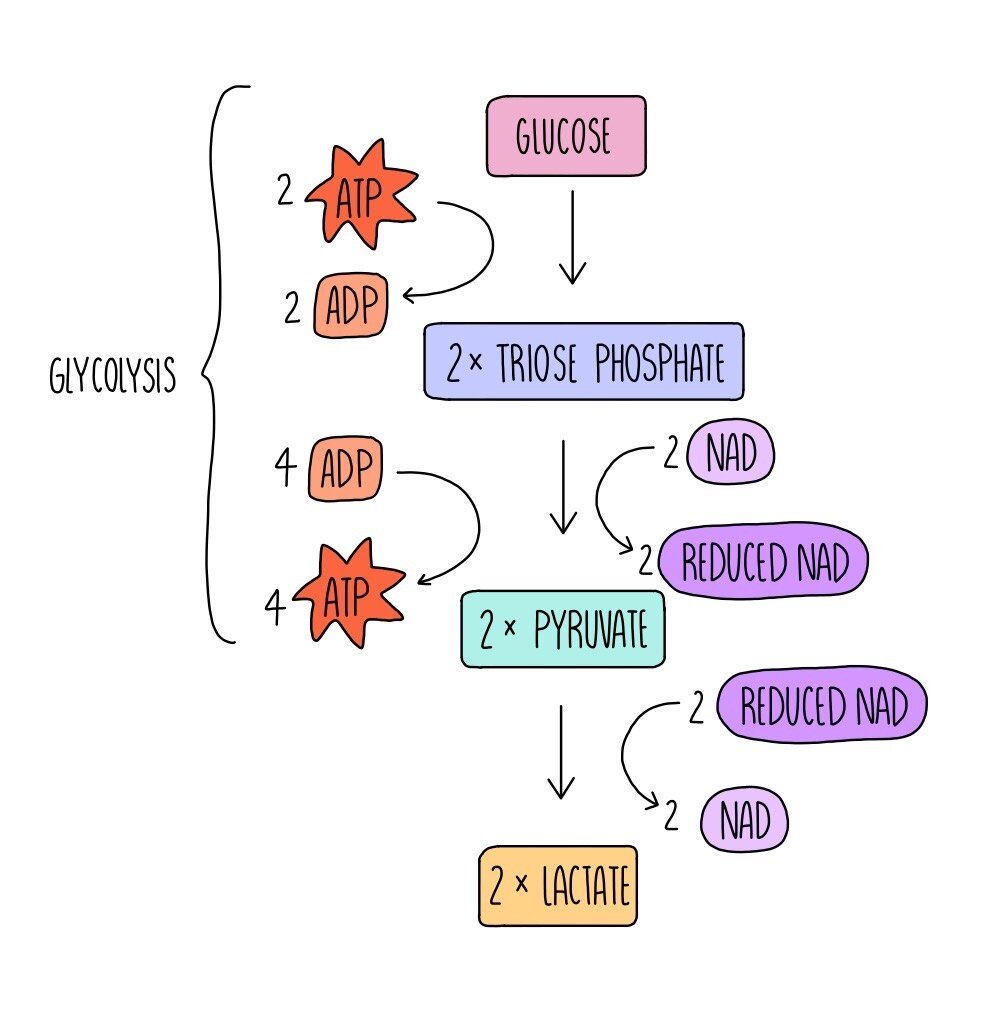During Anaerobic Respiration Glucose Molecules Are Converted Into Molecules of
In a cell aerobic respiration occurs mainly in the _____. E Humans Dogs.

Anaerobic Respiration The Definitive Guide Biology Dictionary
During anaerobic respiration in muscles such as occurred during exercise the lactic acid fermentation takes place by which the pyruvate is converted into the lactic acid.

. In this process glucose breaks down to form alcohol and carbon dioxide with the release of a small amount of energy. It is found in deep-seated tissues plants and animals germinating seeds yeasts and bacteria. This respiration takes place in the absence of oxygen.
Glucose is converted to 3 carbon compound pyruvate by glycolysis. There is lactate production in animals and ethanol plus carbon dioxide in plants. How many molecules of ATP are formed from each molecule of glucose during aerobic respiration.
All of the choices are correct. When the muscles perform vigorous activity and there is less supply of oxygen the cells perform anaerobic type of respiration. In the absence of oxygen it enters the anaerobic respiration where it is converted to lactate.
The glycolysis is the process by which one molecule of glucose is converted into two molecules of pyruvate. Anaerobic respiration occurs in the absence of oxygen. In aerobic respiration glucose molecules are converted into acetyl CoA molecules when they enter the Krebs cycle.
The reaction is catalyzed by the enzyme lactic acid dehydrogenase. Figure 246 Aerobic versus Anaerobic Respiration The process of anaerobic respiration converts glucose into two lactate molecules in the absence of oxygen or within erythrocytes that lack mitochondria. Together contain less chemical energy than was found in the original glucose molecule.
During cellular respiration glucose is converted into two pyruvic acid molecules. During aerobic respiration glucose is oxidized into two pyruvate molecules. Anaerobic respiration has fewer steps so lets start there.
This is the process of taking one glucose sugar molecule and breaking it down into pyruvate and energy 2 ATP. In the absence of oxygen in muscles pyruvate is converted to lactic acid. Answered on 19th Nov 2020.
Statement I Two ATP molecules are produced during anaerobic respiration. Glucose gets converted into CO2 and H2O by producing a large number ATP molecules. What happens if you have enough glucose.
Each pyruvate enters the Krebs cycle as acetyl-CoA. Together contain less chemical energy than was found in the original glucose molecule. Anaerobic respiration without oxygen During glycolysis glucose molecules six-carbon molecules are split into two pyruvates three-carbon.
That glycolysis breaks down glucose 6 carbons into 2 3-carbon pyruvate molecules and that the energy reward for this is ATP and NADH. The pyruvate enters mitochondria and is reduced to carbon dioxide. Lactic acid fermentation is a type of anaerobic respiration.
The first step in both anaerobic and aerobic respiration is called glycolysis. During the respiration of an organism A 1 molecule of glucose produces 2 ATP molecules whereas in the respiration of another organism B 1 molecule of glucose produces 38 ATP moleculesa Which organism is undergoing aerobic respirationb Which organism is undergoing anaerobic respirationc Which type of organism A or B can convert glucose into alcohold. C Organism A can convert glucose into alcohol as it undergoes anaerobic respiration.
So Under aerobic conditions the net formation of ATP until the formation of pyruvate is 2 ATP 1 NADH 3 ATP 5 ATP. During cellular respiration glucose is converted into two pyruvic acid molecules. Thus the ATP molecules produced in anaerobic.
The process of anaerobic respiration converts glucose into two lactate molecules in the absence of oxygen or within erythrocytes that lack mitochondria. During anaerobic respiration each molecule of glucose is converted into 2 molecules of pyruvate. Yeast behaves like organism A.
Statement II Glucose is converted into pyruvic acid through a series of reactions with a net gain of 2 ATP molecules. All of the choices are correct. Anaerobic cell respiration glycolysis fermentation produces 2 ATPglucose consumed.
Lactic acid fermentation is an anaerobic fermentation process in which glucose or any other six-carbon sugar is converted to lactic acid lactate and cellular energy occurring in the muscle cells due to ample physical exertion or exercise in the absence of oxygen. Depending on the microcellular environment specifically oxygen availability energy demand and the presence or absence of mitochondria pyruvate has several separate fates. It happens in the cytoplasm.
Are each converted into a two-carbon molecule joined to a coenzyme A molecule. Through the process of glycolysis one molecule of glucose breaks down to form two molecules of pyruvate. Thus during aerobic respiration one glucose molecule gives 233 molecules of ATP in glycolysis only.
Are each converted into a two-carbon molecule joined to a coenzyme A molecule. During aerobic respiration glucose is oxidized into two pyruvate molecules. Hence organism A can convert glucose into alcohol.
Each turn of the Krebs cycle yields 3. Biochemistry Anaerobic Glycolysis - StatPearls - NCBI Bookshelf. We will discuss this in depth during aerobic respiration.
A Both the statements are individually true and the Statement II is the correct explanation of the Statement I. In anaerobic respiration glucose breaks down to form alcohol and carbon dioxide with the release of small amount of energy. During anaerobic respiration of yeast two ATP molecules are produced from each glucose molecule.
Each lose a carbon atom which is released as CO2. That glycolysis is the first step of aerobic respiration and is the only energy-producing step in anaerobic respiration. The glucose then is converted to its ready use form glycogen.
Aerobic cell respiration glycolysis the Krebs cycle respiratory electron transport produces 36 ATPglucose consumed. In animals where there is sufficient oxygen supply pyruvate enters the mitochondria and is completely oxidized to carbon dioxide. In anaerobic conditions there is no conversion of NADH to ATP.
Click to view a larger image.

In Anaerobic Respiration From One Glucose Molecule How Many Net Atp Molecules Are Formed

Respiration A Level The Science Hive

The Above Figure Is A Simplified Scheme Showing The Fate Of Glucose During Aerobic And Anaerobic Respiration Identify The End Products That Are Formed At Stages Indicated As A B C And
0 Response to "During Anaerobic Respiration Glucose Molecules Are Converted Into Molecules of"
Post a Comment